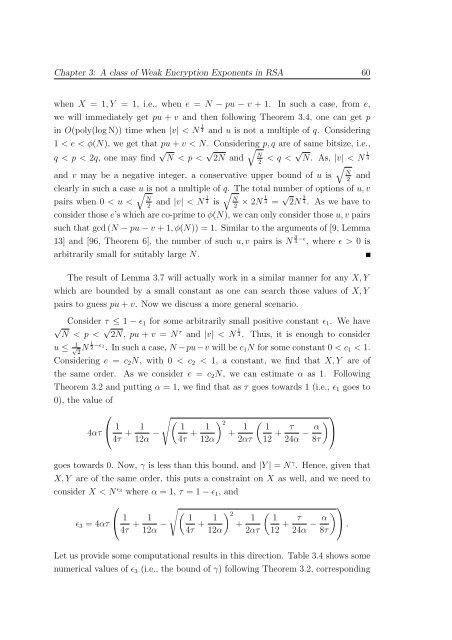Cryptanalysis of RSA Factorization - Library(ISI Kolkata) - Indian ...
Cryptanalysis of RSA Factorization - Library(ISI Kolkata) - Indian ...
Cryptanalysis of RSA Factorization - Library(ISI Kolkata) - Indian ...
You also want an ePaper? Increase the reach of your titles
YUMPU automatically turns print PDFs into web optimized ePapers that Google loves.
Chapter 3: A class <strong>of</strong> Weak Encryption Exponents in <strong>RSA</strong> 60<br />
when X = 1,Y = 1, i.e., when e = N − pu − v + 1. In such a case, from e,<br />
we will immediately get pu + v and then following Theorem 3.4, one can get p<br />
in O(poly(logN)) time when |v| < N 1 4 and u is not a multiple <strong>of</strong> q. Considering<br />
1 < e < φ(N), we get that pu+v < N. Considering p,q are <strong>of</strong> same bitsize, i.e.,<br />
q < p < 2q, one may find √ N < p < √ 2N and<br />
√<br />
N<br />
< q < √ N. As, |v| < N 1 4<br />
2<br />
√<br />
N<br />
and v may be a negative integer, a conservative upper bound <strong>of</strong> u is and 2<br />
clearly in such a case u is not a multiple <strong>of</strong> q. The total number <strong>of</strong> options <strong>of</strong> u,v<br />
√ √<br />
N<br />
pairs when 0 < u < and |v| < N 1 N<br />
4 is × 2N 1 4 = √ 2N 4. 3 As we have to<br />
2 2<br />
considerthosee’swhichareco-primetoφ(N), wecanonlyconsiderthoseu,v pairs<br />
such that gcd(N −pu−v +1,φ(N)) = 1. Similar to the arguments <strong>of</strong> [9, Lemma<br />
13] and [96, Theorem 6], the number <strong>of</strong> such u,v pairs is N 3 4 −ǫ , where ǫ > 0 is<br />
arbitrarily small for suitably large N.<br />
The result <strong>of</strong> Lemma 3.7 will actually work in a similar manner for any X,Y<br />
which are bounded by a small constant as one can search those values <strong>of</strong> X,Y<br />
pairs to guess pu+v. Now we discuss a more general scenario.<br />
Consider τ ≤ 1 − ǫ 1 for some arbitrarily small positive constant ǫ 1 . We have<br />
√<br />
N < p <<br />
√<br />
2N, pu + v = N τ and |v| < N 1 4. Thus, it is enough to consider<br />
u ≤ 1 √<br />
2<br />
N 1 2 −ǫ 1<br />
. In such a case, N−pu−v will be c 1 N for some constant 0 < c 1 < 1.<br />
Considering e = c 2 N, with 0 < c 2 < 1, a constant, we find that X,Y are <strong>of</strong><br />
the same order. As we consider e = c 2 N, we can estimate α as 1. Following<br />
Theorem 3.2 and putting α = 1, we find that as τ goes towards 1 (i.e., ǫ 1 goes to<br />
0), the value <strong>of</strong><br />
4ατ<br />
⎛ √ (<br />
⎝ 1<br />
4τ + 1 1<br />
12α − 4τ + 1 ) 2<br />
+ 1<br />
12α 2ατ<br />
( 1<br />
12 + τ<br />
24α − α ) ⎞ ⎠<br />
8τ<br />
goes towards 0. Now, γ is less than this bound, and |Y| = N γ . Hence, given that<br />
X,Y are <strong>of</strong> the same order, this puts a constraint on X as well, and we need to<br />
consider X < N ǫ 3<br />
where α = 1, τ = 1−ǫ 1 , and<br />
ǫ 3 = 4ατ<br />
⎛ √ (<br />
⎝ 1<br />
4τ + 1 1<br />
12α − 4τ + 1 ) 2<br />
+ 1<br />
12α 2ατ<br />
( 1<br />
12 + τ<br />
24α − α ) ⎞ ⎠.<br />
8τ<br />
Let us provide some computational results in this direction. Table 3.4 shows some<br />
numerical values <strong>of</strong> ǫ 3 (i.e., the bound <strong>of</strong> γ) following Theorem 3.2, corresponding
















